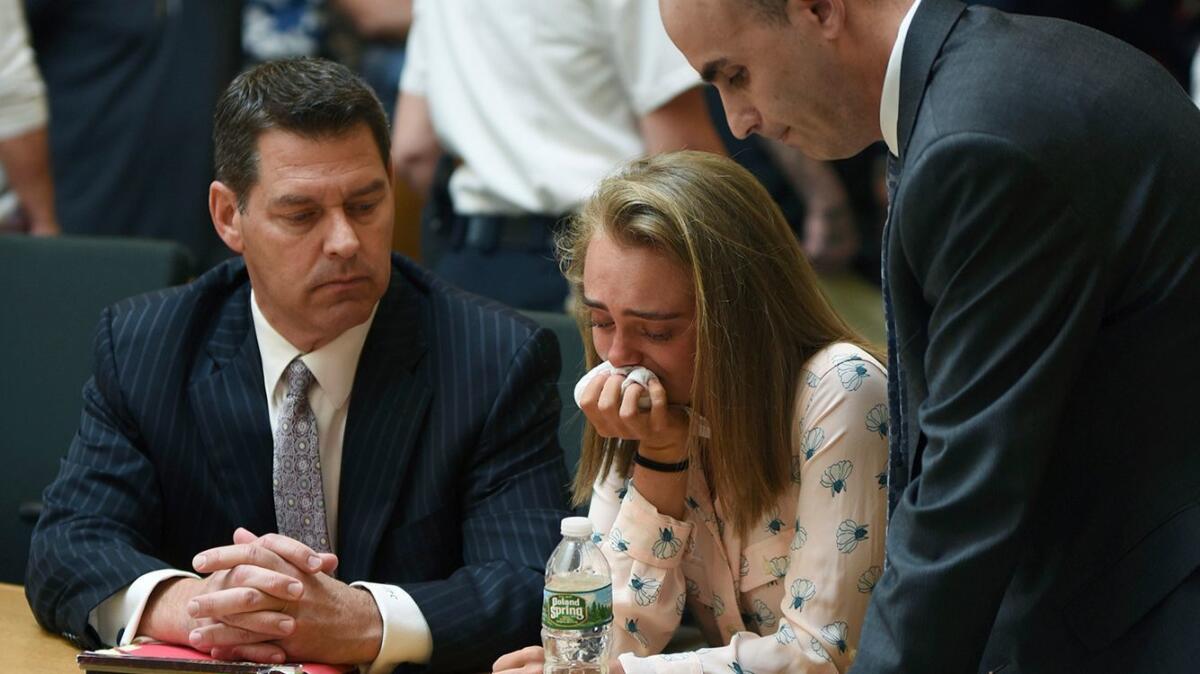Michelle Carter found guilty in Massachusetts texting suicide case

Michelle Carter was found guilty of involuntary manslaughter on June 16 for her 18-year-old boyfriendâs suicide. (June 16, 2017) (Sign up for our free video newsletter here http://bit.ly/2n6VKPR)
Reporting from New York â Putting a modern spin on the definition of manslaughter, a Massachusetts judge found Michelle Carter guilty in the death of an 18-year-old friend she had instructed to kill himself in a series of text messages and mobile-telephone conversations.
The decision by Bristol Juvenile Judge Lawrence Moniz in the bench trial could have future ramifications for criminal cases involving online speech and assisted suicide.
The novel case rested on more than 1,000 Facebook and text messages exchanged between Carter and her boyfriend, Conrad Roy III, as well as messages Carter sent friends afterward explaining her role.
Roy was found dead in the cab of his pickup truck in the parking lot of a Kmart on July 13, 2014, with a tube from a generator pumping in carbon monoxide.

Up to the moment he passed out from the toxic fumes, then 17-year-old Carter was on the telephone with him, she later informed friends. When he had doubts and climbed out of the truck, she ordered him back in.
âShe can hear him coughing and she can hear the loud noise of the motor,ââ the judge said in his ruling Friday. Her instructions to return to the truck constituted âwanton and reckless conduct by Ms. Carter, creating a situation where there is a high degree of likelihood that substantial harm would result to Mr. Roy.â
The notoriety of the case turned Carter, a gaunt blond with dark pursed eyebrows, into a modern-day villainess in social media,where people tweeted threats such as, âI hope you rot in jail forever,ââ and âMichelle Carter is a witch.â
Tears welled up in Carterâs eyes and she uttered an audible sob as the verdict was read, but she stood upright and still, as though she had accepted the eventuality of a conviction.
I think it will embolden more prosecutors to bring cases like this,
— Laurie Levenson of Loyola Law School
Now 20, Carter had waived her right to a jury trial, her lawyerâs reasoning that a judge would assess her culpability more strictly on the basis of the law.
Sentencing is set for Aug. 3. Carter could face up to 20 years in prison on the conviction for involuntary manslaughter, although such a long sentence would seem unlikely. Moniz allowed Carter to remain free on bail until her sentencing.
In her texts leading up to Royâs death, Carter belittled her boyfriend for failing to make good on previous threats to commit suicide and made him promise that he would follow through. She sent him research on different methods, including hanging and jumping off a high building, and finally settled on carbon monoxide poisoning. Carter advised Roy to do it away from home so that nobody would interrupt and stop his death.
âAnd u canât break a promise. And just go in a quiet parking lot or something,â she wrote him.
When Roy wrote that he didnât want to hurt his parents, Carter reassured him: âI think your parents know youâre in a really bad place. Im not saying they want you to do it, but I honestly feel like they can accept it.â
Although the case was decided by a county juvenile court judge, legal scholars said it could have a profound effect on how courts think about suicide in the future.
âIt may not set a legal precedent, because I donât think it does at this level of court, but its notoriety will have an impact. I think it will embolden more prosecutors to bring cases like this,ââ said Laurie Levenson of Loyola Law School.
Daniel Medwed of the Northeastern School of Law said he thought Carter might have a chance of reversing the decision on appeal.
âWhen many of us read her text messages, our stomachs churn and we want her to be held accountable, but that doesnât mean it is manslaughter. It always struck me as a reach,â said Medwed. âThe classic form of manslaughter is the driver who strikes a pedestrian or the person who shoots into a crowd. ⌠The judge was basically updating manslaughter as a doctrine to apply to contemporary circumstances. The text communications were in a sense the metaphorical gun.â
Both teenagers had a history of psychological problems. Carter had struggled with anorexia and self-cutting. Roy had tried to kill himself as many as four times previously. The teenagers had met two years before his death on vacation with their families in Florida and realized that they lived near each other on the outskirts of Boston. In their text messages â they rarely saw each other in person â they professed their love, at one point deciding they would kill themselves like Romeo and Juliet, but Carter rejected the idea and focused instead on getting Roy alone to commit suicide.
Prosecutors said that Roy was turning the corner on escaping his depression and would not have killed himself if not for the pressure from Carter. He had recently earned a maritime captainâs license and was set to attend Fitchburg State University in the fall.
âEvery time he came up with an excuse not to do it, she kicked his feet from under him,â prosecutor Katie Rayburn said.
Royâs suicide would allow Carter to play the role of the grieving girlfriend, enhancing her social status at high school. She wrote posts on Facebook about how she would become an anti-suicide activist and organized a baseball tournament in his memory, though in Plainville, Mass., where she lived â not in his hometown of Mattapoisett, where most of his friends were.
Carter did not testify. The defense relied heavily on the testimony of a celebrity psychiatrist, Peter R. Breggin, who has written several books criticizing psychiatric medication. He testified that Carter, who was 17 at the time of Royâs death, had delusions of grandeur that made her believe that Roy would be better off dead.
âSheâs not thinking sheâs doing something criminal. ⌠Sheâs found a way to help her boyfriend,â Breggin told the court. âHe wants to die, he wants to go to heaven ... she will help him, just the way he wants it.â
In his ruling, the judge said he âdid not find that analysis credible.ââ The decision, he said, rested heavily on the moments when Roy got out of his truck to get a breath of fresh air and was ordered by Carter to get back inside. Although it was Roy who took all the steps leading to his own death â researched the method, secured the generator and rigged it to the car â he appeared to have had second thoughts, just as happened in past suicide attempts when he called a friend or a parent at the last minute.
âShe instructs Mr. Roy to get back into the truck well knowing of all the feeling he has exchanged with her, his ambiguities, his fears, his concern,ââ the judge said.
In the past, prosecutors have been unsuccessful in bringing charges against people who bullied others into suicide. Dharun Ravi, a Rutgers student, was convicted of bias intimidation, invasion of privacy and other crimes in 2012 after the suicide of his roommate, whom he had recorded in a romantic encounter with another man. The case was thrown out on appeal and he pleaded guilty to lesser charges.
Prosecutors decided not to bring manslaughter charges against Lori Drew, a Missouri mother who set up a fake MySpace account that led to the suicide of a 13-year-old girl, and a 2008 conviction for computer fraud was later thrown out.
Families of the teenagers had little to say after the verdict. Royâs father, Conrad Roy Jr., told reporters âweâd like to just process this verdict that weâre happy with.â
ALSO
Can words kill? Michelle Carter on trial for urging her 18-year-old boyfriend to kill himself
Girl stands trial in connection to boyfriendsâ suicide
Woman who sent texts urging boyfriend to kill himself is convicted of manslaughter
UPDATES:
1:55 p.m.: This article was updated with statements from the judge and the family of Conrad Roy III about the verdict.
This article was originally published at 8:50 a.m.
More to Read
Sign up for Essential California
The most important California stories and recommendations in your inbox every morning.
You may occasionally receive promotional content from the Los Angeles Times.










